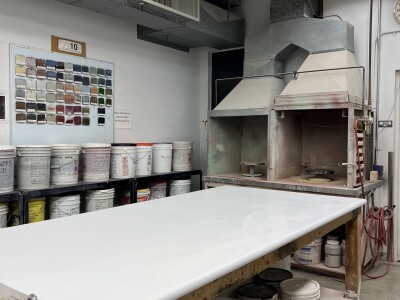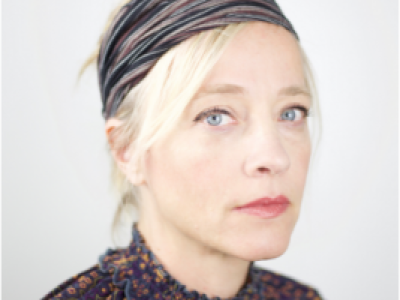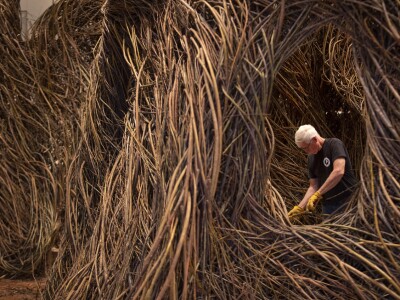sculpture
data-content-type="article"
History of the Making: BYU Students, Faculty and Alumni Share Their Art at the Springville Museum of Art’s 100th Salon
Springville Museum of Art Features Utah Artists in Centennial Show; BYU has Partnered with Them Throughout History
overrideBackgroundColorOrImage=
overrideTextColor=
promoTextAlignment=
overrideCardHideSection=
overrideCardHideByline=
overrideCardHideDescription=
overridebuttonBgColor=
overrideButtonText=
promoTextAlignment=
data-content-type="article"
BYU’s Art Labs Provide Space, Materials and Support for Art Students
The Department of Art Provides Ample Resources to Help Their Students Succeed
overrideBackgroundColorOrImage=
overrideTextColor=
promoTextAlignment=
overrideCardHideSection=
overrideCardHideByline=
overrideCardHideDescription=
overridebuttonBgColor=
overrideButtonText=
promoTextAlignment=
data-content-type="article"
Art For All: BYU Offers Non-Major Art Classes
BYU Students and Faculty Believe that Art Classes Benefit Non Art Majors on Campus
overrideBackgroundColorOrImage=
overrideTextColor=
promoTextAlignment=
overrideCardHideSection=
overrideCardHideByline=
overrideCardHideDescription=
overridebuttonBgColor=
overrideButtonText=
promoTextAlignment=
data-content-type="article"
Faith + Works: Ashlee Whitaker On Art as a Spiritual Text
Ashlee Whitaker, curator of religious art at BYU’s Museum of Art, shared experiences where art and faith meet
overrideBackgroundColorOrImage=
overrideTextColor=
promoTextAlignment=
overrideCardHideSection=
overrideCardHideByline=
overrideCardHideDescription=
overridebuttonBgColor=
overrideButtonText=
promoTextAlignment=
data-content-type="article"
Art Alumni Feature: Jen Harmon Allen
After years of perfecting a non-traditional sculpting method amidst personal trial, Jennifer Harmon Allen is ready to be patient with more delicate processes
overrideBackgroundColorOrImage=
overrideTextColor=
promoTextAlignment=
overrideCardHideSection=
overrideCardHideByline=
overrideCardHideDescription=
overridebuttonBgColor=
overrideButtonText=
promoTextAlignment=
data-content-type="article"
Alumni Feature: Michael Whiting
Minimalism meets video games in Whiting’s pixel-based sculptures
overrideBackgroundColorOrImage=
overrideTextColor=
promoTextAlignment=
overrideCardHideSection=
overrideCardHideByline=
overrideCardHideDescription=
overridebuttonBgColor=
overrideButtonText=
promoTextAlignment=
data-content-type="article"
BYU Magazine: Minuscule Masterpieces
The Harold B. Lee Library had some unusual visitors in October. Just inside the east doorways, miniature patrons admired postage stamp–sized art in one of alumna McKay Lenker Bayer’s (BA ’18) latest Tiny Art Shows. She held her first back in 2016 for a BYU art class, hanging self-made bitty art a few inches off the ground on Provo’s Center Street. Bayer added the final touches—a tiny spotlight and magnifying glass—and staked out a spot to watch. “I was amazed by the reaction—people squealed with joy, even lay down on the dirty sidewalk to get a good look,” says Bayer. See the full article by Lauren K. Lethbridge at magazine.byu.edu.
overrideBackgroundColorOrImage=
overrideTextColor=
promoTextAlignment=
overrideCardHideSection=
overrideCardHideByline=
overrideCardHideDescription=
overridebuttonBgColor=
overrideButtonText=
promoTextAlignment=
data-content-type="article"
Alumni Feature: Heidi Somsen
Heidi Somsen grew up in British Columbia, where she played regularly in the ocean and gathered items from along the coast. Her innate interest in the earth and materiality drove Somsen to become an artist, but it wasn’t until she took her first foundations class at BYU that she recognized her love for 3D mediums. When Somsen graduated with her BFA in 1995, her oldest child was three years old. Determined to keep making art in the midst of raising young children, Somsen created wherever she found space—“whether the kitchen table or my little basement studio”—and continued to participate in one or two shows each year. Years later, Somsen said her artwork is a form of spiritual practice, as well as a way for her to process life “and all the big ideas in our human existence.” Read the full story at art.byu.edu.
overrideBackgroundColorOrImage=
overrideTextColor=
promoTextAlignment=
overrideCardHideSection=
overrideCardHideByline=
overrideCardHideDescription=
overridebuttonBgColor=
overrideButtonText=
promoTextAlignment=
data-content-type="article"
New Digital Fabrication Tools Expand Students’ Art-Making In Digital Sculpture Class
In a new digital sculpture class taught by Associate Professor Collin Bradford, students explore the material, formal and conceptual potential of sculpture using new technologies. Digital 3D: Sculpture with Digital Tools is one of two new courses offered as part of the Art and Technology track within the BA degree. Students enrolled in digital sculpture learn the basics of 3D modeling, 3D rendering and creating physical objects from digital models using a 3D printer, laser cutter and a CNC machine (also called a CNC router). Continue reading on the Department of Art’s website.
overrideBackgroundColorOrImage=
overrideTextColor=
promoTextAlignment=
overrideCardHideSection=
overrideCardHideByline=
overrideCardHideDescription=
overridebuttonBgColor=
overrideButtonText=
promoTextAlignment=
data-content-type="article"
‘Windswept’: The Art of Bending Trees
Before the load was shipped from upstate New York to Brigham Young University’s Museum of Art, they were put in a freezer for two weeks at minus 20 degrees (to kill any bugs) then de-leaved and fire-retarded. Post-delivery, the saplings have been bent and twisted into something strikingly new: “Windswept,” a towering, contorting sculpture that seems unreal. That the piece was erected in only three weeks seems equally unbelievable. “Windswept” will be open for viewing starting Dec. 7, continuing through mid-October of next year. Read more here. Photo by Steve Griffin, Deseret News.
overrideBackgroundColorOrImage=
overrideTextColor=
promoTextAlignment=
overrideCardHideSection=
overrideCardHideByline=
overrideCardHideDescription=
overridebuttonBgColor=
overrideButtonText=
promoTextAlignment=
data-content-type="article"
BYU MOA acquires casts of famous ‘Gates of Paradise’
The BYU Museum of Art recently acquired plaster casts of Ghiberti’s “Gates of Paradise.” The original artwork decorates doors on the San Giovanni Baptistery in Florence, Italy, but the MOA will take charge of preserving and displaying the casts in Provo. The relief sculptures depict Old Testament stories on 10 3-foot-square panels, carved by Renaissance sculptor Lorenzo Ghiberti in the early 1400s. Former BYU art professor Sharon Gray discovered the casts in a storage room at BYU-Hawaii, where she was a service missionary. She began negotiations, and BYU-Hawaii allowed the MOA to acquire the casts earlier this year. Gray was organizing BYU-Hawaii’s art collection when she made the discovery. She had visited Florence and seen the original “Gates of Paradise” in 1984 on a study abroad program, allowing her to recognize the white plaster heads as soon as she saw them in a crate in Hawaii. Gray made a few phone calls and confirmed the casts’ identity with an archivist. Gray said the plaster panels had been resting in crates in the university’s storage areas for more than 30 years. “It’s a little like Indiana Jones,” Gray said. Jan Fisher, a former art faculty member at BYU-Hawaii, had acquired the casts from Florence and shipped them to Hawaii. There are conflicting stories about when the casts were made and when Fisher acquired them. However, the word “1984” was scrawled across one of the crates underneath Italian packing tape reading “fragile” and “Firenze.” Gray said Fisher originally thought the gates would be a good addition to the Polynesian Cultural Center, but this didn’t work out, and the panels went in storage. “The Renaissance and the Polynesian Cultural Center don’t really mix,” Gray said. “There’s a dissonance there, even though they’re both paradise.” BYU-Hawaii doesn’t have an art museum, so the two universities collaborated to transfer the panels to Provo for proper care, preservation and display. MOA senior registrar Trevor Weight and head fabricator John Adams packed the original 11 boxes into five padded, custom-built crates. The pieces were then freighted to Los Angeles and trucked to Provo, arriving in early July. The casts sat untouched in the museum vaults for several months to allow them to settle and adjust to changes in humidity. The MOA discovered only a few small cracks after unpacking the panels. Weight said he expected some damage from vibrations caused by planes and trucks, but he was surprised at how well the casts transferred. There were also no apparent effects from the change in climate. BYU Museum of Art director Mark Magleby said the “Gates of Paradise” are often viewed as a starting point of the Florentine Renaissance. In the year 1400, Ghiberti competed against six other artists to win the commission for the doors on the south side of the Florence Cathedral baptistery. He earned the commission and created his first set of doors, then was hired to create a second set. Two generations later, Michelangelo studied the second set of doors and nicknamed them the “Gates of Paradise,” a mantra which has been used since. Magleby said the doors significantly influenced Renaissance artists, especially Michelangelo. “He found in those doors the inspiration to do his High Renaissance style,” Magleby said. “Exquisite naturalism in the anatomy of the figure, proportional figures in space; that’s something that was achieved pretty radically in Ghiberti’s second set of doors.” Magleby said the museum has not yet determined how to display the panels. Opinions vary on whether to leave them as white plasters or to coat the surface with a patina to better represent the original work, but Magleby said the first thing the museum will address is the piece’s conservation by sealing the surfaces to protect them from dust and pollution. There are at least two choices when it comes to displaying the panels in the museum, Magleby said. One option is reassembling them vertically like the original doors so viewers can get a sense of the work’s magnitude. Another option is displaying each panel horizontally so viewers can see greater detail and work chronologically through the Old Testament stories. Magleby said the museum would like to leave both options open so viewers can appreciate the panels in different ways at different times. “It was a tremendous act of generosity and faith that BYU-Hawaii would entrust us with these,” Magleby said. “We’re glad that they knew that we are so careful with our objects that they would receive cautious, proactive attention for their preservation, conservation and preparation for viewing.”
overrideBackgroundColorOrImage=
overrideTextColor=
promoTextAlignment=
overrideCardHideSection=
overrideCardHideByline=
overrideCardHideDescription=
overridebuttonBgColor=
overrideButtonText=
promoTextAlignment=
data-content-type="article"
BYU Exhibition Celebrates Centuries of Christ-themed Art
For the Christian artist, the psalmist’s charge to “magnify the Lord” is naturally achieved through paint, brush, chisel or sculpting tool. The life, teachings and gospel of Jesus Christ have been taught through paintings and sculptures for centuries. READ MORE >>>>>
overrideBackgroundColorOrImage=
overrideTextColor=
promoTextAlignment=
overrideCardHideSection=
overrideCardHideByline=
overrideCardHideDescription=
overridebuttonBgColor=
overrideButtonText=
promoTextAlignment=
data-content-type="article"
Stewart Art Collection at Museum of Art highlights bold colors, vivid hues of Southwest
In the late 19th and early 20th centuries, artists flocked to the American Southwest captivated by its rugged, unspoiled landscape and the native people who had been there for hundreds of years. The artistic visions of this land and its people captured in vivid hues and bold colors on the canvases of these painters continue to resonate today as museums and collectors compete with increasing enthusiasm to build collections of Southwest art. “Visions of the Southwest from the Diane and Sam Stewart Art Collection,” a new exhibition at the BYU Museum of Art opening Friday, Feb. 13, will feature 124 works of art from the private collection of Diane and Sam Stewart, Utah art collectors and friends of the museum. It will be on view in the Marian Adelaide Morris Cannon Gallery on the museum’s main level through July 3, and admission is free. The Museum of Art will host an opening reception for this exhibition on Thursday, Feb. 12, from 7 to 9 p.m. The Stewarts and museum staff will be available to answer questions about the works in this exhibition during this time. There will also be live music and light refreshments. This reception is free and open to the public. The oil paintings, works on paper, and sculpture in this collection were created by many of the master artists of Taos and Santa Fe, New Mexico – including Oscar E. Berninghaus, Bert Phillips, E. Martin Hennings, Joseph Henry Sharp, Georgia O’Keeffe, Conrad Buff, and Freemont Ellis – as well as their contemporaries in California, Utah, and other Western states. Native American baskets, pots, and rugs from the Stewart’s collection and furniture from the Gerald Peters Gallery in Santa Fe will complement a number of the works in the exhibition. “The Stewarts belong to a tradition of collecting Southwest art,” said Museum of Art Curator Paul Anderson. “This art has thrilled people for more than 100 years. And many have come to see the works produced by these artists as truly American because they relate us to our roots and connect us to the unspoiled land of the West.” Anglo artists discovered Taos and other Pueblo settlements around the rugged Sangre de Cristo Mountains in the late 19th century. By the early years of the new century, artists’ colonies were thriving at Taos and Santa Fe. Enthralled with the stunning scenic vistas that surrounded them, the painters were drawn even more by the local cultures that had coexisted in peaceful serenity over the centuries. These artists, who had mostly trained in Europe and the best Eastern schools, saw the Southwest landscape and people as fresh subject matter for a distinctly American art form. They saw the Pueblo culture as a perfect example of a people gaining strength from lives lived in harmony with nature, a striking contrast to the fast paced, competitive, industrial culture coming to dominate the rest of the country. The generation of artists who arrived before the end of World War I, including Berninghaus, Phillips, Hennings, and Sharp, generally worked in traditional, representational styles they had mastered in their earlier studies. But these Taos artists were impelled to employ new techniques to effectively render the open, arid vistas and hard, white brightness of the high desert terrain. They often used brighter, more intense colors and broader brushstrokes than they had previously employed in their landscapes and figures. Many artists who arrived after 1918, including O’Keeffe, Buff, and Ellis, produced works that were often more influenced by modernist trends that stressed the elemental shapes and the core ideas underlying the dramatic scenery and exotic local culture. “The Stewarts have created a harmonious setting for these works of art in their rambling Southwest-style home in Palm Springs, California. The paintings are displayed together with collections of pottery, baskets, and other objects from Native American and Hispanic artists and artisans of the Southwest,” Anderson said. “We wanted the museum’s exhibition of this superb collection to give visitors a small taste of what it would be like to visit the Stewarts in Palm Springs, surrounded by beautiful art and fine craftsmanship.” A cell phone tour will be available for this exhibition. MP3 players pre-loaded with the audio tour will also be available to check out for free from the Information Desk on the main level. Free docent-led tours will be conducted during regular museum hours and must be scheduled at least one week in advance. Tours usually last about one hour. Call (801) 422-1140 to schedule a tour. For more information about the museum, visitors can call (801) 422-8287 or visit moa.byu.edu. Source: BYU News
overrideBackgroundColorOrImage=
overrideTextColor=
promoTextAlignment=
overrideCardHideSection=
overrideCardHideByline=
overrideCardHideDescription=
overridebuttonBgColor=
overrideButtonText=
promoTextAlignment=











